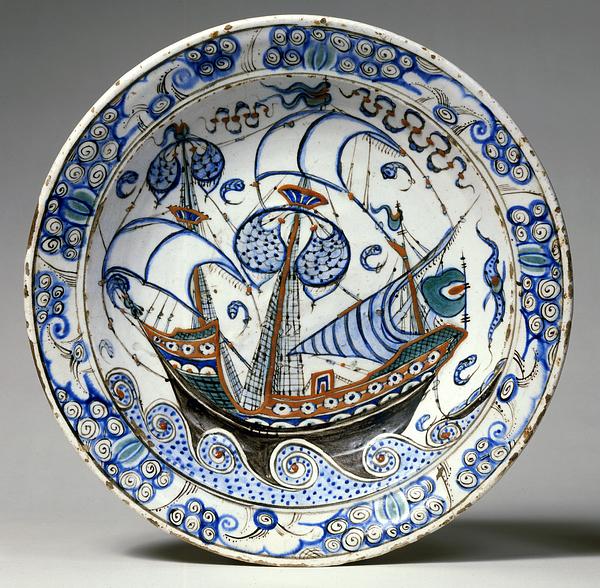Fritware dish, painted in blue, green, and black and with a red slip under a transparent glaze
Turkey, Iznik; c. 1600
H: 6.8; Diam: 36 cm
Istanbul was a lively center of trade, and many ships, both Turkish and Western, called at its harbor. Most of the Turkish vessels were light, fast ships with lateen sails, like the one depicted on a flask (
11/1971). Western European galleys were much heavier, and this dish shows a monumental oceangoing three-master on the raging sea.
What were presumably the muzzles of threatening cannons were transformed by the Turkish potter into flowerheads. An early example of the slogan Make Love, Not War?
Inv. no. 24/1975
Published in:
Barbara Kellner-Heinkele, Dorothea Rohwedder (eds.): Türkische Kunst und Kultur aus osmanischer Zeit, Museum für Kunsthandwerk, Frankfurt am Main, Recklinghausen 1985, cat.no. 2/47, p. 163;
Esin Atil: The age of Sultan Süleyman the Magnificent, National Gallery of Art, Washington, D.C. 1987, cat.no. 201;
Soliman le Magnifique: 15 fevrier au 14 mai 1990, Galeries Nationales du Grand Palais, Paris 1990, cat.no. 86;
Kjeld von Folsach: Islamic art. The David Collection, Copenhagen 1990, cat.no. 200;
Kjeld von Folsach, Torben Lundbæk and Peder Mortensen (eds.): Sultan, Shah and Great Mughal: the history and culture of the Islamic world, The National Museum, Copenhagen 1996, cat.no. 182;
Kjeld von Folsach: Art from the World of Islam in The David Collection, Copenhagen 2001, cat.no. 275;
Walter B. Denny: Iznik: the artistry of Ottoman ceramics, London 2004, pp. 184-185;
Walter B. Denny: Iznik : la céramique turque et l'art ottoman, Paris 2004, pp. 184-185;
John A. Burrison: Beautiful clay: a traditional craft as art, Bloomington, Indiana 2025, pp. 174, 186 and p. 182, fig. 3.39;
